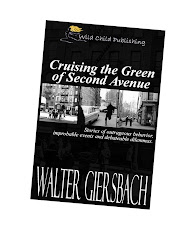I'm on the
edge of the Pine Barrens that make up almost a quarter of New Jersey. Yet few outsiders know about the dwarf
forests, ghost towns, and the forests that rely on fire in order to generate
new growth. My friend and celebrated
Pine Barrens author Louise Barton told me,
“The Pine Barrens is unique, with different vegetation, trees and
wildlife. The vegetation rots as the
rain percolates down. Even today, the
water in the many lakes is the shade of murky, iced tea.”
This may have influenced settlers, beginning in 1674. “The settlers used to collect rain water that
pocketed at the tree roots and use it as a medicine. Due to the rotting vegetation, the natural
waterways often ran the color of blood and mists blanketed the forests. This supernatural setting helped stir the
imagination, and the Jersey Devil was conceived. Further skullduggery was accounted for by the
Moonrakers — land pirates who posted lights to lure ships onto the shore — and
sea pirates and privateers prowling offshore.
Witch hunters were quick to accuse the early settlers, and Ben Franklin
mentioned the witch trials held at Mt. Holly.”
Towns like Atsion, Chatsworth,
Batsto, Double Trouble, Harrisville, Martha, and Whitesbog Village were once
thriving industrial and agricultural centers.
Now, except for a few residents’ homes, you may only find building
foundations. It’s estimated there may be
as many as 100 deserted towns in the Pine Barrens.
The earliest
permanent European settlers began occupying the area in 1674. Hamlets and coastal towns were based on
shipbuilding, commerce and timber-based trades.
For a century after 1760 iron, charcoal, and glass industries flourished. By 1830, there were 655 sawmills in the
state; today there are about 75 sawmills here.
And it all
has virtually disappeared except for small towns and “Pineys” who share a
unique culture.
On a summer
day, try exploring the ghost town of Friendship. This was the heart of a 3,000-acre cranberry
farm. It was founded in 1869 on the site of a sawmill dating back
to 1795. For a time, the cranberry
business here was the largest in the area, but it declined and was sold to real
estate speculators in the 1950s. A
one-room schoolhouse is the only surviving structure, and it’s somewhere
else. Today,
foundation ruins of the abandoned town can be found in the field to the east
side of Carranza Road and south side of Friendship-Speedwell Road.
 |
|
All that’s left of the Hampton Furnace
operation.
|
Isolated deep in the Pinelands, Harrisville is a genuine ghost town from the 1800s. Once a flourishing village, it was abandoned
in 1891 after the great paper mill, the driving force of the community, closed.
Today the mill’s evocative ruins can be seen, but are fenced off for safety and
preservation reasons. Harrisville
is about 8 miles northwest of New Gretna, where the highway crosses the east
branch of the Wading River. Almost
nothing remains except for a few crumbling foundations and canal remnants. The area is covered with dense undergrowth.
Travel down to Hampton
Furnace to find the ruins
of a late 18th century furnace and, later, cranberry operation along the Batsto
River. Information on the Hampton Furnace is scarce,
but it was opened about 1795 and was in operation until about 1850. The furnace smelted bog iron found in nearby swamps
and bogs. This site may also have produced
cannonballs and shot for the War of 1812. To find Hampton Furnace, make
your way to Hammonton and travel northeast out of town on Route 206 to Atsion
(Route 206 at Atsion Rd.). Go slightly
beyond the town and take a right on Hampton Rd. Follow this road for two to three miles until
you get to Riders Switch and Glossy Spung Rd/High Crossing Rd. The remains are in that area.
And
this is just an introduction. There are
other “ghost towns”, like Hermann, site of a late 19th century glass factory on the Mullica River; Martha, and the ruins of the bog iron smelting furnace that flourished from 1793-1845; Pasadena or Brooksbrae and the extensive runs of a brick-making factory amid the encroaching forest; and Weymouth Furnace, where the Great Egg Harbor River runs by grand stone arches, a towering
chimney stack, and moss-covered foundations from the old mill – all that now
remain of this historical landmark.
(Sources
for this article can be found at http://www.sitesofnj.com/index.html, http://www.e90post.com/forums/showthread.php?t=1109136
and http://www.pinelandsalliance.org/history/places/)
Warning: If you choose to visit the
Pine Barrens off-road, be aware of “sugar sand” in such places as Friendship.
Sugar sand consists of tiny grains and can be very slippery even when
dry. Your vehicle may get stuck. More important, warns
Louise Barton, “If you are lost in the woods, you may get no cell phone signal
to call for help. Hikers and hunters may
wander aimlessly for hours, and two grown men cried with relief when I was able
to direct them to the road just two miles down.”


